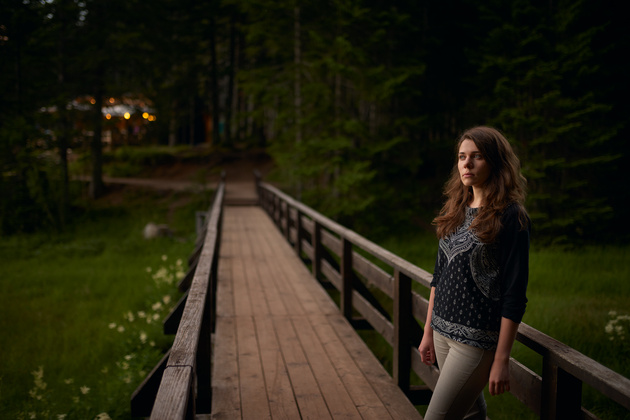So, the sun went over the horizon, and dusk came. The first hour of twilight, photographers are sometimes called the "blue hour": at this time, the lighting is soft, gentle, pleasing to the eye. No wonder the blue hour is part of the regime time. The time when the lighting conditions are most beneficial for shooting. During this period, you can make beautiful mysterious portraits using the lighting that nature offers. I try not to spoil the natural light using the flash, especially the built-in. At the same time, photographing in twilight conditions requires the photographer to know his own technique, to properly configure it and to use suitable optics. In this article, I will give some tips for taking portraits at dusk.
- Watch the shutter speed . For shooting moving objects, the shutter speed must be shorter than 1/60 sec. The brightness of lighting during dusk is greatly reduced. So, taking pictures becomes more difficult. It’s much easier to get a defective, blurry frame like this:
- Landscape and people can complement each other in the frame. Remember this when shooting in beautiful places! Do not rush to blur the background as much as possible and certainly use long-focus optics. Try to add space, atmosphere to the frame!
- Watch for focus accuracy. The autofocus system, like a person, at dusk sees a little worse. Give it a discount. Recall that the phase type of autofocus (working when composing a frame through the viewfinder of a SLR camera) in the dark is more sensitive than contrast. Therefore, if possible, it is worth composing the frame through the optical viewfinder of the camera, and not through the Live View screen. The most sensitive focus point is traditionally considered the central one. If you have trouble focusing, use it. Later, you can always recompose the shot by holding the shutter button half-pressed.
- Use high-aperture optics. Fast fixed lenses should be in the arsenal of any photographer taking portraits. In addition to the fact that such lenses provide excellent image quality and can beautifully blur the background, they allow you to take better pictures in poor lighting conditions. Lenses with aperture of f / 1.4 and f / 1.8 are great. By the way, not all of them cost a lot of money. For example, the Nikon AF-S 50mm f / 1.8G Nikkor lens has a rather low price tag, and the image produces a very “expensive” one, as if it were shot with optics costing several times higher.
- Full-frame SLR cameras will be more convenient. Why? In my opinion, primarily because they have a large and high-quality optical viewfinder. In it you will look at the future frame not as in a keyhole, but as in a full-fledged window. In addition, full-frame cameras produce less digital noise at high ISOs, which is important when shooting at dusk. A worthy choice today will be the Nikon D610, Nikon D750, Nikon D810.
- Be creative in your exposure. It is not necessary to make the evening shot light, as if it were shot in the afternoon. To convey the feeling of evening and twilight in the photo, try to take a frame with a slight negative exposure correction. But, of course, one should not go to extremes: if your frame is completely dark, this can also be considered a technical marriage.
- Use elements of city lighting. City illumination can complement your shot. With it, you can highlight the face of the model (by placing a light source on the side or front of it) or decorate the background. By the way, at dusk against the background, not only city lights look interesting, but also the moon. Try to catch her in the frame!


